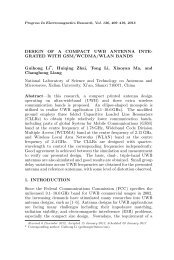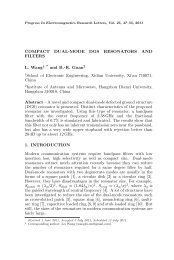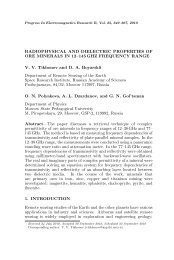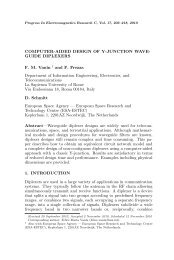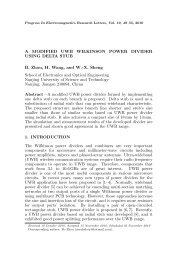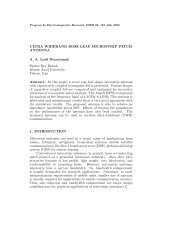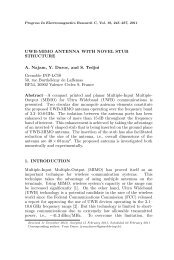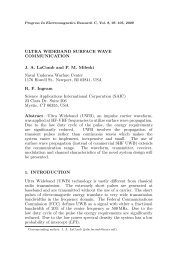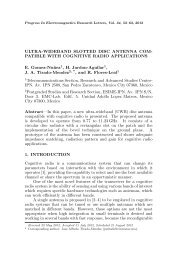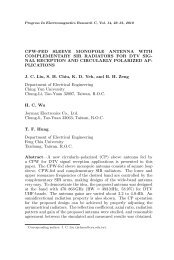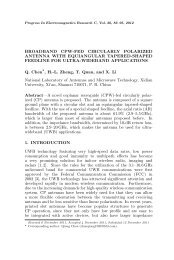LINEAR AND CIRCULAR ARRAY OPTIMIZATION: A STUDY ... - PIER
LINEAR AND CIRCULAR ARRAY OPTIMIZATION: A STUDY ... - PIER
LINEAR AND CIRCULAR ARRAY OPTIMIZATION: A STUDY ... - PIER
You also want an ePaper? Increase the reach of your titles
YUMPU automatically turns print PDFs into web optimized ePapers that Google loves.
368 Khodier and Al-Aqeel<br />
4. CONCLUSIONS<br />
In this paper, different antenna array types are optimized using the<br />
PSO method. This paper illustrates how to model the design of<br />
non-uniform antenna arrays for single or multi objective optimization.<br />
The well-known method of PSO is proposed as the solution for these<br />
design problems. This method efficiently computes the design of<br />
several antenna arrays to generate a radiation pattern with desired<br />
properties. In the first part of the paper, we dealt with linear arrays.<br />
The optimization objectives were: first, minimize the maximum SLL<br />
by adjusting the excitation amplitudes, excitation phases or elements<br />
positions along the x-axis, and then adjust all the previous parameters<br />
simultaneously. The numerical results show that the PSO method<br />
produces minimum SLL compared with the uniform conventional array<br />
and the array obtained from the Tabu search optimization (TSO)<br />
method. Second, we minimized the close-in SLL while minimizing the<br />
maximum far SLL. Results show that considerable reduction in the<br />
close-in SLL is achieved. Third, PSO is used to minimize the average<br />
SL power by adjusting all possible array parameters individually and<br />
then all of them simultaneously. Results found from PSO show that<br />
the average SL power obtained is lower than the uniform conventional<br />
array one. Fourth, the array excitation phases are adjusted with<br />
PSO to perform beamsteering in certain direction. The PSO is<br />
also used to optimize elements locations, excitations amplitude and<br />
excitation phases of circular arrays. The results found show that<br />
the maximum SLL obtained is lower than the uniform conventional<br />
array and GA array, and the array beamwidth is thinner. For<br />
practical implementation of circular array, a circular dipole array is<br />
optimized to minimize the maximum SLL. The method of moments<br />
is used to determine the current distributions on the dipoles. The<br />
optimized parameters are elements excitation amplitude, excitation<br />
phases, locations and lengths. The results show that minimum SLL<br />
can be achieved by optimizing these parameters using the PSO method.<br />
REFERENCES<br />
1. Schelkunoff, S., “A mathematical theory of linear arrays,” Bell<br />
Systems Technology Journal, Vol. 22, No. 1, 80–107, 1943.<br />
2. Keizer, W. P., “Fast low-sidelobe synthesis for large planar array<br />
antennas utilizing successive fast fourier transform of the array<br />
factor,” IEEE Trans. on Antennas and Propagat., Vol. 55, No. 3,<br />
715–730, March 2007.<br />
3. Woodward, P. M. and J. P. Lawson, “The theoretical precision





